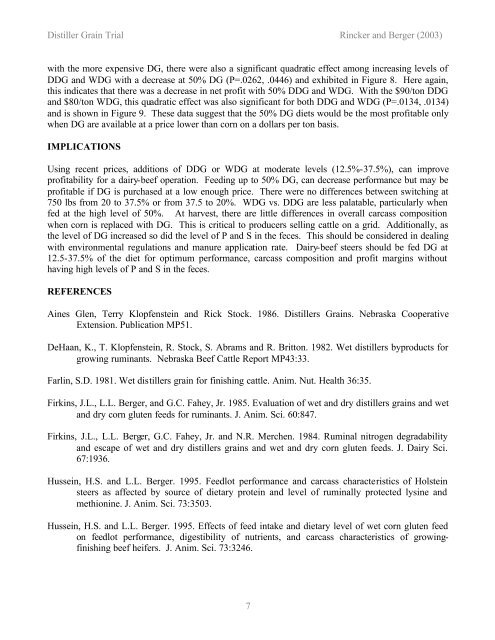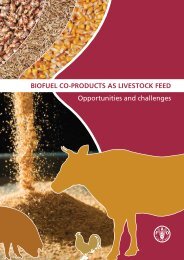Distillers Grains Feeding Recommendations. - Distillers Grains By ...
Distillers Grains Feeding Recommendations. - Distillers Grains By ...
Distillers Grains Feeding Recommendations. - Distillers Grains By ...
You also want an ePaper? Increase the reach of your titles
YUMPU automatically turns print PDFs into web optimized ePapers that Google loves.
Distiller Grain Trial Rincker and Berger (2003)with the more expensive DG, there were also a significant quadratic effect among increasing levels ofDDG and WDG with a decrease at 50% DG (P=.0262, .0446) and exhibited in Figure 8. Here again,this indicates that there was a decrease in net profit with 50% DDG and WDG. With the $90/ton DDGand $80/ton WDG, this quadratic effect was also significant for both DDG and WDG (P=.0134, .0134)and is shown in Figure 9. These data suggest that the 50% DG diets would be the most profitable onlywhen DG are available at a price lower than corn on a dollars per ton basis.IMPLICATIONSUsing recent prices, additions of DDG or WDG at moderate levels (12.5%-37.5%), can improveprofitability for a dairy-beef operation. <strong>Feeding</strong> up to 50% DG, can decrease performance but may beprofitable if DG is purchased at a low enough price. There were no differences between switching at750 lbs from 20 to 37.5% or from 37.5 to 20%. WDG vs. DDG are less palatable, particularly whenfed at the high level of 50%. At harvest, there are little differences in overall carcass compositionwhen corn is replaced with DG. This is critical to producers selling cattle on a grid. Additionally, asthe level of DG increased so did the level of P and S in the feces. This should be considered in dealingwith environmental regulations and manure application rate. Dairy-beef steers should be fed DG at12.5-37.5% of the diet for optimum performance, carcass composition and profit margins withouthaving high levels of P and S in the feces.REFERENCESAines Glen, Terry Klopfenstein and Rick Stock. 1986. <strong>Distillers</strong> <strong>Grains</strong>. Nebraska CooperativeExtension. Publication MP51.DeHaan, K., T. Klopfenstein, R. Stock, S. Abrams and R. Britton. 1982. Wet distillers byproducts forgrowing ruminants. Nebraska Beef Cattle Report MP43:33.Farlin, S.D. 1981. Wet distillers grain for finishing cattle. Anim. Nut. Health 36:35.Firkins, J.L., L.L. Berger, and G.C. Fahey, Jr. 1985. Evaluation of wet and dry distillers grains and wetand dry corn gluten feeds for ruminants. J. Anim. Sci. 60:847.Firkins, J.L., L.L. Berger, G.C. Fahey, Jr. and N.R. Merchen. 1984. Ruminal nitrogen degradabilityand escape of wet and dry distillers grains and wet and dry corn gluten feeds. J. Dairy Sci.67:1936.Hussein, H.S. and L.L. Berger. 1995. Feedlot performance and carcass characteristics of Holsteinsteers as affected by source of dietary protein and level of ruminally protected lysine andmethionine. J. Anim. Sci. 73:3503.Hussein, H.S. and L.L. Berger. 1995. Effects of feed intake and dietary level of wet corn gluten feedon feedlot performance, digestibility of nutrients, and carcass characteristics of growingfinishingbeef heifers. J. Anim. Sci. 73:3246.7
















